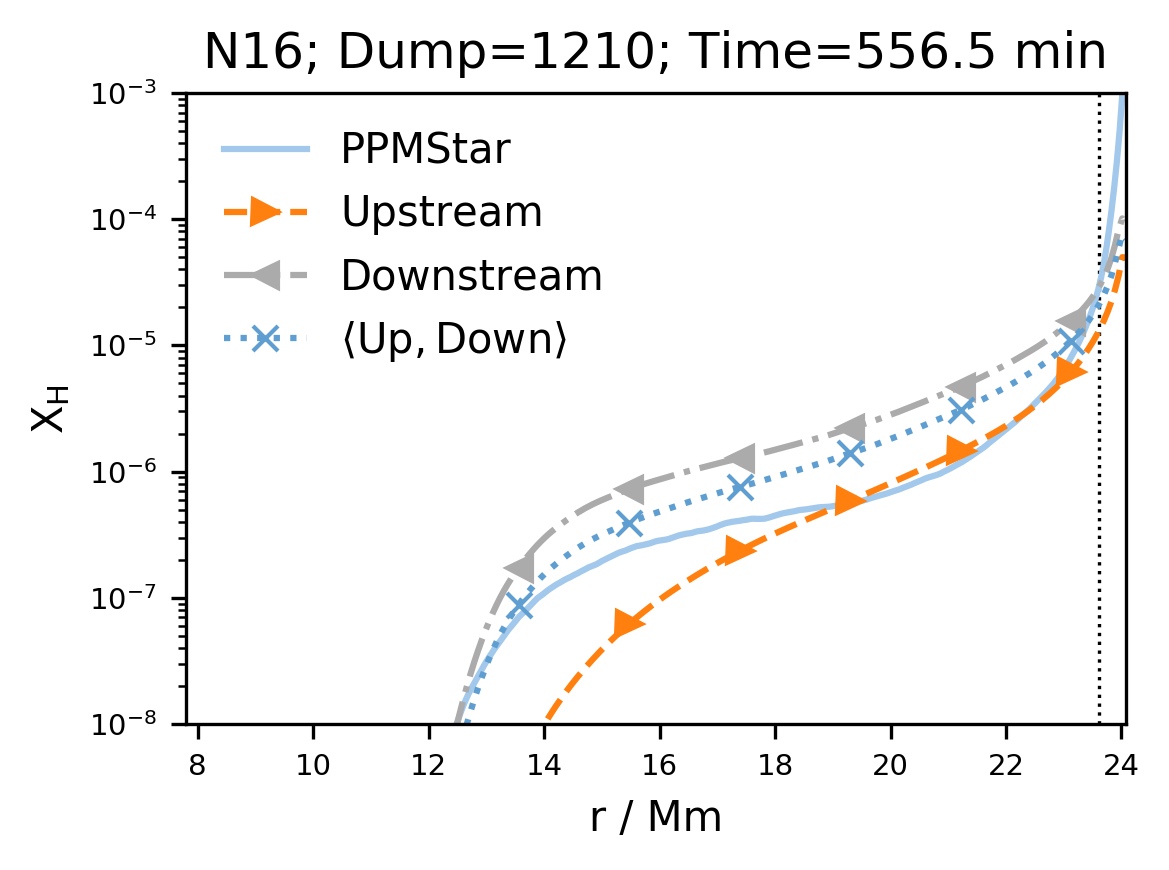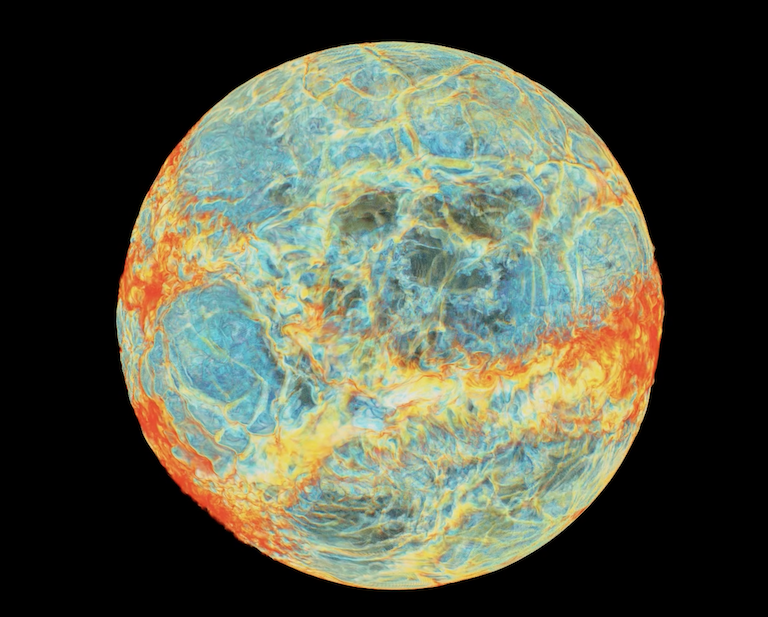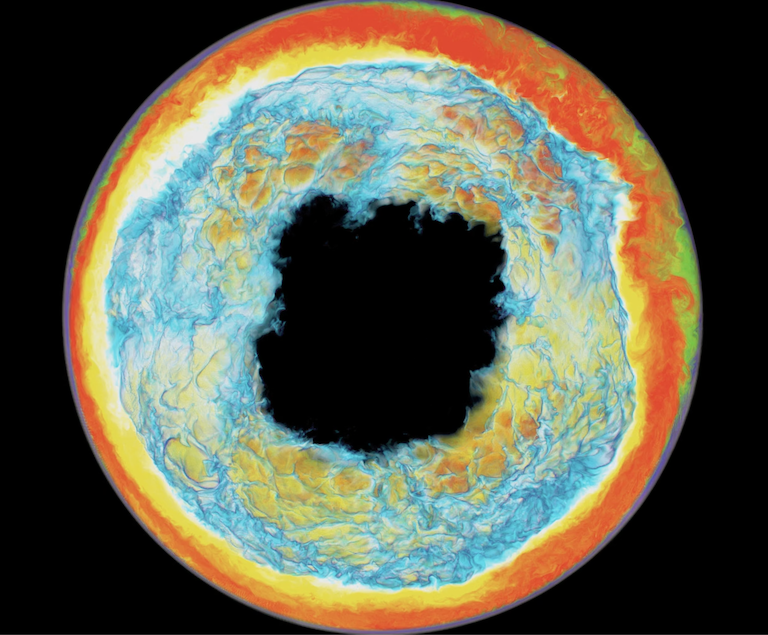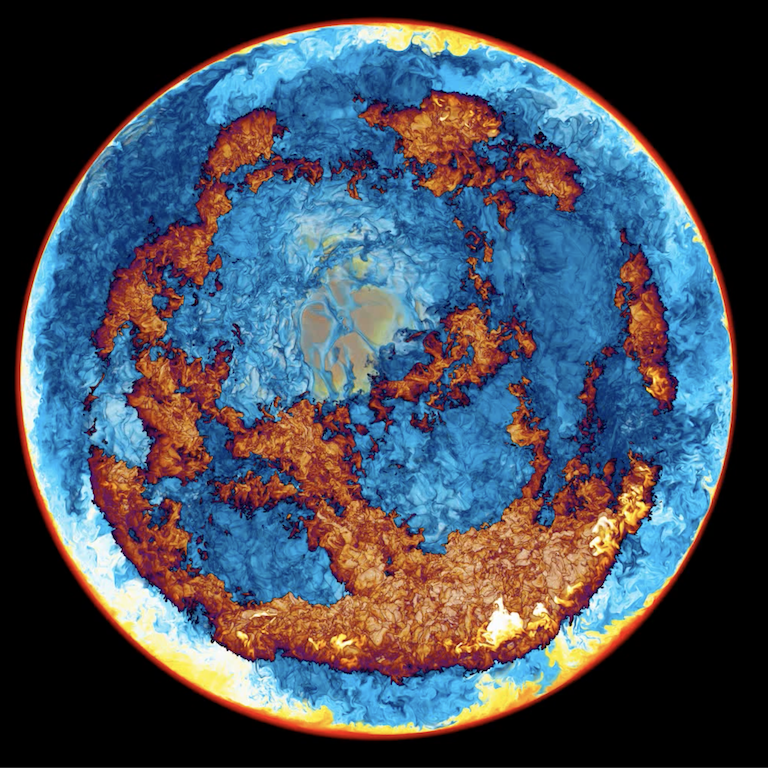The PPMstar collaboration investigates stellar hydrodynamics through large-scale 3-dimensional simulations. Each of the color boxes below describes one PPMstar project and provides links to additional online media, such as high-resolution images and movies.
3D hydrodynamics simulations of a
Simon Blouin, Falk Herwig, Huaqing Mao, Pavel Denissenkov, Paul R. Woodward. 2023. MNRAS submitted.
The inner structure of core-helium burning (CHeB) stars remains uncertain due to the yet unknown nature of mixing at the boundary of their cores. Large convective cores beyond a bare Schwarzschild model are favoured both from theoretical arguments and from asteroseismological constraints. However, the exact nature of this extra mixing, and in particular the possible presence of semiconvective layers, is still debated. In this work, we approach this problem through a new avenue by performing the first full-sphere 3D hydrodynamics simulations of the interiors of CHeB stars. We use the
3D hydrodynamics simulations of core convection in supermassive main-sequence stars.
Blouin, Simon; Mao, Huaqing ; Woods, Tyrone E. ; Denissenkov, Pavel ; Woodward, Paul R. ; Herwig, Falk.
2023. MNRAS, 521, 4605.
Supermassive stars are Population III stars with masses exceeding
3D hydrodynamics simulations of internal gravity waves in red giant branch stars
Simon Blouin, Huaqing Mao, Falk Herwig, Pavel Denissenkov, Paul R. Woodward, William R. Thompson
We present the first 3D hydrodynamics simulations of the excitation and
propagation of internal gravity waves (IGWs) in the radiative interiors of
low-mass stars on the red giant branch (RGB). We use the PPMstar explicit gas
dynamics code to simulate a portion of the convective envelope and all the
radiative zone down to the hydrogen-burning shell of a 1.2
3D hydrodynamic simulations of massive main-sequence stars
Team: Herwig, Falk; Woodward, Paul; Mao, Huaqing; Thompson, William; Denissenkov, Pavel; Bouin, Simon; Bowman, Dominic; Andrassy, Robert; Lau, Josh et al.
We present 3D hydrodynamic simulations of core convection in a 25 solar mass star. The first three papers of this project are now available on arXiv
- Movies web link
- Paper I (published) Dynamics and mixing of convection and internal gravity waves
- Paper II (submitted) Convective excitation and spectra of internal gravity waves
- Paper III (submitted) The effect of radiation pressure and diffusion leading to a 1D equilibrium model
3D hydrodynamic simulations of massive main-sequence stars -- IV. Internal gravity waves matter for SLF variability
Praneet Pathak, Simon Blouin, Falk Herwig, Paul R. Woodward.
2025. Submitted to The Astrophysical Journal.
The power spectrum of light curves from satellites like CoRoT and TESS of massive main-sequence stars have shown stochastic low-frequency (SLF) variability or excess power in the low frequency regime. We present the results of 3D hydrodynamic simulations of a 25 solar-mass star to investigate this phenomenon. Our modeling encompasses most of the stellar structure, including both core and outer envelope convection zones. The simulation results match observed variability patterns, with internal gravity waves (IGWs) originating from the thin outer envelope convection boundary identified as the primary driver. Controlled experiments isolating different stellar regions demonstrate that the full stellar configuration, rather than envelope convection alone, produces the observed low-frequency power characteristics. We conclude that IGWs excited at the thin outer envelope convection inner boundary and interacting with the thin outer envelope convection are the dominant contributors to SLF variability.

|
3D1D hydro-nucleosynthesis simulations. I. Advective-reactive post-processing method and
its application to H ingestion into He-shell flash convection in rapidly accreting white
dwarfs
Stephens, David; Herwig, Falk; Woodward, Paul; Denissenkov, Pavel; Andrassy, Robert;
Mao, Huaqing. 2020. MNRAS 504, 744.
- Paper on NASA ADS
- Movies
- More movies web link including movies of the 15363-grid run N16
We present two mixing models for post-processing of 3D hydrodynamic simulations applied to convective-reactive i-process nucleosynthesis in a rapidly accreting white dwarf (RAWD) with [Fe/H] =−2.6, in which H is ingested into a convective He shell. A 1D advective two-stream model adopts physically motivated radial and horizontal mixing coefficients constrained by 3D hydrodynamic simulations. A simpler approach uses diffusion coefficients calculated from the same simulations. All 3D simulations include the energy feedback of the12C(p,γ)13N reaction from the H entrainment. Global oscillations of shell H ingestion in two of the RAWD simulations cause bursts of entrainment of H and non-radial hydrodynamic feedback. With the same nuclear network as in the 3D simulations, the 1D advective two-stream model reproduces the rate and location of the H burning within the He shell closely matching the 3D simulation predictions, as well as qualitatively displaying the asymmetry of the XH profiles between the up- and downstream. With a full i-process network the advective mixing model captures the difference in the n-capture nucleosynthesis in the up- and downstream. For example, 89Kr and 90Kr with half-lives of 3.18 min and 32.3 s differ by a factor 2 - 10 in the two streams. In this particular application the diffusion approach provides globally the same abundance distribution as the advective two-stream mixing model. The resulting i-process yields are in excellent agreement with observations of the exemplary CEMP-r/s star CS31062-050.

|
3D Hydrodynamic Simulations of C Ingestion into a Convective O Shell
Andrassy R, Herwig F, Woodward P, Ritter C. 2020. MNRAS. 491(1):972-992
Interactions between convective shells in evolved massive stars have been linked to supernova impostors, to the production of the odd-Z elements Cl, K, and Sc, and they might also help generate the large-scale asphericities that are known to facilitate shock revival in supernova explosion models. We investigate the process of ingestion of C-shell material into a convective O-burning shell, including the hydrodynamic feedback from the nuclear burning of the ingested material. Our 3D hydrodynamic simulations span almost 3 dex in the total lumunosity Ltot. All but one of the simulations reach a quasi-stationary state with the entrainment rate and convective velocity proportional to Ltot and Ltot1/3 , respectively. Carbon burning provides 14-33 percent of the total luminosity, depending on the set of reactions considered. Equivalent simulations done on 7683 and 11523 grids are in excellent quantitative agreement. The flow is dominated by a few large-scale convective cells. An instability leading to large-scale oscillations with Mach numbers in excess of 0.2 develops in an experimental run with the energy yield from C burning increased by a factor of 10. This run represents most closely the conditions expected in a violent O-C shell merger, which is a potential production site for odd-Z elements such as K and Sc and which may seed asymmetries in the supernova progenitor. 1D simulations may underestimate the energy generation from the burning of ingested material by as much as a factor 2 owing to their missing the effect of clumpiness of of entrained material on the nuclear reaction rate.
Idealized hydrodynamic
simulations of turbulent oxygen-burning shell convection in 4π
geometry
Jones S., Andrassy R., Sandalski S., Davis A.,
Woodward P., Herwig F. 2017. MNRAS. 465:2991.
This work investigates the properties of convection in stars with particular emphasis on entrainment across the upper convective boundary (CB). Idealized simulations of turbulent convection in the O-burning shell of a massive star are performed in 4π geometry on 7683 and 15363 grids, driven by a representative heating rate. A heating series is also performed on the 7683 grid. The 15363 simulation exhibits an entrainment rate at the upper CB of 1.33 × 10-6 M☉/s. The 7683 simulation with the same heating rate agrees within 17 per cent. The entrainment rate at the upper CB is found to scale linearly with the driving luminosity and with the cube of the shear velocity at the upper boundary, while the radial rms fluid velocity scales with the cube root of the driving luminosity, as expected. The mixing is analysed in a 1D diffusion framework, resulting in a simple model for CB mixing. The analysis confirms that limiting the MLT mixing length to the distance to the CB in 1D simulations better represents the spherically averaged radial velocity profiles from the 3D simulations and provide an improved determination of the reference diffusion coefficient D0 for the exponential diffusion CB mixing model in 1D. From the 3D simulation data, we adopt as the CB the location of the maximum gradient in the horizontal velocity component which has 2σ spatial fluctuations of ≈0.17HP. The exponentially decaying diffusion CB mixing model with f = 0.03 reproduces the spherically averaged 3D abundance profiles.
Hydrodynamic Simulations of H Entrainment at the Top of He-shell Flash Convection
Woodward P. R., Herwig F., Lin P.-H. 2015. The Astrophysical Journal. 798:49.
We present the first three-dimensional, fully compressible gas-dynamics simulations in 4π geometry of He-shell flash convection with proton-rich fuel entrainment at the upper boundary. This work is motivated by the insufficiently understood observed consequences of the H-ingestion flash in post-asymptotic giant branch (post-AGB) stars (Sakurai's object) and metal-poor AGB stars. Our investigation is focused on the entrainment process at the top convection boundary and on the subsequent advection of H-rich material into deeper layers, and we therefore ignore the burning of the proton-rich fuel in this study. We find that for our deep convection zone, coherent convective motions of near global scale appear to dominate the flow. At the top boundary convective shear flows are stable against Kelvin-Helmholtz instabilities. However, such shear instabilities are induced by the boundary-layer separation in large-scale, opposing flows. This links the global nature of thick shell convection with the entrainment process. We establish the quantitative dependence of the entrainment rate on grid resolution. With our numerical technique, simulations with 10243 cells or more are required to reach a numerical fidelity appropriate for this problem. However, only the result from the 15363 simulation provides a clear indication that we approach convergence with regard to the entrainment rate. Our results demonstrate that our method, which is described in detail, can provide quantitative results related to entrainment and convective boundary mixing in deep stellar interior environments with very stiff convective boundaries. For the representative case we study in detail, we find an entrainment rate of 4.38 ± 1.48 × 10-13 M☉/s.
Global Non-spherical Oscillations in Three-dimensional 4π Simulations of the H-ingestion
Flash.
Herwig F., Woodward P. R., Lin P.-H., Knox M., Fryer C. 2014. The Astrophysical Journal
Letters. 792:L3.
We performed three-dimensional simulations of proton-rich material entrainment into 12C-rich He-shell flash convection and the subsequent H-ingestion flash that took place in the post-asymptotic giant branch star Sakurai's object. Observations of the transient nature and anomalous abundance features are available to validate our method and assumptions, with the aim of applying them to very low-metallicity stars in the future. We include nuclear energy feedback from H burning and cover the full 4π geometry of the shell. Runs on 7683 and 15363 grids agree well with each other and have been followed for 1500 minutes and 1200 minutes. After an 850 minute long quiescent entrainment phase, the simulations enter into a global non-spherical oscillation that is launched and sustained by individual ignition events of H-rich fluid pockets. Fast circumferential flows collide at the antipode and cause the formation and localized ignition of the next H-overabundant pocket. The cycle repeats for more than a dozen times while its amplitude decreases. During the global oscillation, the entrainment rate increases temporarily by a factor of ≈100. Entrained entropy quenches convective motions in the upper layer until the burning of entrained H establishes a separate convection zone. The lower-resolution run hints at the possibility that another global oscillation, perhaps even more violent, will follow. The location of the H-burning convection zone agrees with a one-dimensional model in which the mixing efficiency is calibrated to reproduce the light curve. The simulations have been performed at the NSF Blue Waters supercomputer at NCSA.

|

|

|
The Hubs tab provides access to different JupyterHub services that allow analytic and exploratory access to PPMstar stellar hydro simulation outputs. We aim to provide the data and the notebooks required to make the figures in our published papers. If you want to just try out some notebooks use the Outreach Hub. If you want to do more substantial research on this platform please contact us and we can provide you enhanced storage, data access and persistence in the PPMstar Collaborate hub.
For access to Public & Outreach, PPMstar Collaborate and CoCo hub you need to register.
The Movies tab provides a gallery of movies from a range of projects. The highest-resolution PPMstar movies are not suitable to be shared through this web page. Movie links to such high-resolution media can be found for individual on the Research tab.
PPMstar collaboration
In the PPMstar collaboration Paul Woodward, Director of
the Laboratory for
Computational Science and Engineering at the Univeristy of
Minnesota and Falk Herwig, Head of
the Computational Stellar
Astrophysics group at the Universitiy of Victoria combine
their interests and expertise in stellar physics, numerical
methods, nuclear astrophysics and computational tools and
processes to address key scientific challenges related to
stellar interior convection. PPMstar is Paul Woodward's
3D stellar hydro code and it is optimized to solve problems in
stellar convection. Some key questions the PPMstar
collaboration is interested in are:
- What is the physics of convective boundary mixing and entrainment? And how can results from 3D simulations be applied in 1D stellar evolution simulations?
- How is rapid and energetic nuclear burning of entrained or ingested fuel into a convection zone altering the hydrodynamic flows in so-called convective-reactive combustion regimes, such as convective shell mergers. What kind of nucleosynthesis can take place in such violent convective-reactive pre-suprenova environments?
- What are the special stellar hydrodynamic properties in the first stars that formed after the Big Bang from metal-free, primordial gas?
- How are internal gravity waves excited by convection in the stellar interior, how do simulation predictions compare with observation of asteroseismology, and what is the nature of mixing induced by internal gravity waves?
Additional resources
Team
Minnesota
- Paul Woodward (F)
- Huaqing Mao (GS)
Victoria
- Falk Herwig (F)
- Pavel Denissenkov (SR)
- Austin Davis (GS)
- Ondrea Clarkson (GS)
- Adam Paul (GS)
- Josh Lau (UG)
Former members
- David Stephens (GS)
- Robert Andrassy (PD → Heidelberg Institute for Theoretical Studies, HITS, Germany)
- Sam Jones (PD → staff member at LANL, Los Alamos, NM, US)
F - faculty, PD - post-doc, SR - senior researcher, GS - graduate students, UG - undergraduate
Acknowledgements
Science
The PPMstar project is supported through an NSERC Discovery Grant to Falk Herwig, and by the National Science Foundation under Grant No. PHY-1430152 (Physics Frontier Center JINA - Center for the Evolution of the Elements). PRW also acknowledges NSF grants 1413548 and AST-1814181.
Computations are enabled by recurrent resource allocations on the Frontera supercomputer at the Texas Advanced Computing Center and the Niagara supercomputer operatated by SciNet at the University of Toronto
Cyberhubs on ppmstar.org
ppmstar.org includes an implementation of the Cyberhubs: Virtual Research Environments for Astronomy system developed by a team lead by Falk Herwig. Cyberhubs combines Docker virtualization with the JupyterHub notebook technology, and incorporates third-party authentication. Cyberhubs allow multiple users to access the same virtual research environment composed of a combination of storage, processing capacity and dedicated software packages specific to the particular research goals.
The advanced data storage, compression and access methods required to make large 3D hydrodynamic simulations accessible in this platform have been developed by Paul Woodward and his team at the University of Minnesota, supported through an NSF CDS&E grant 1413548.
ppmstar.org has implemented a multihub extension to the original Cyberhubs configuration that allows to host multible hubs each with a different combination of access policies, shared data and containerized software stack. The latest version of Cyberhubs and the ppmstar.org web page has been developed, implemented and is operated by Falk Herwig (team leader, requirements, systems design, implementation), Belaid Moa (Research Computing Systems at UVic, technical design and proto-typing), Stephenson Yang (ARC at UVic, development, implementation, maintenance & operation), Adam Paul (student CSA/UVic, html programming), Bryce McEwan (student CSA/UVic, html programming and Widget notebooks).
Aspects and capabilities related to CSA's nuclear astrophysics research (WENDI) have been developed with support from NSF's Physics Frontier Center Joint Institute for Nuclear Astrophysics. An earlier version of Cyberhubs was developed as part of the CANFAR project WENDI, funded by Canarie, UVic and NSERC. Over the years Cyberhubs has been supported by funds from NSERC, CFI via Compute Canada, UVic, EcoCanada.
ppmstar.org is hosted on a 16-core, 120GB memory virtual server of the Arbutus Cloud operated by Research Computing Services at the University of Victoria.